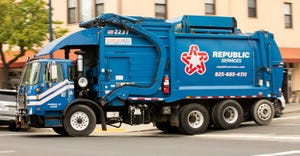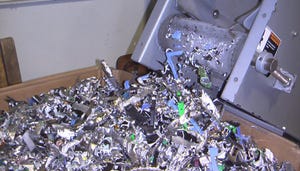management: An Enterprising Way To Run Your Operations
November 1, 1997
David Yanke
You may be held accountable for your solid waste operation, but how accountable is your solid waste operation to you?
Pressured by Subtitle D and competition from the private sector, many municipalities are turning to enterprise funds to operate their solid waste divisions more cost effectively.
In a recent survey, several Texas cities report that they established a solid waste enterprise fund because they depended heavily on user fees, and as a result should be operated on a stand-alone basis.
Enterprise funds account for operational costs like a private business. It helps identify the service costs and revenues and prevents them from being commingled with others in a municipality's general fund.
These funds also allow easier access to capital markets by showing the financial advisor and the rating agencies audited financial statements, along with a reliable revenue stream sufficient to fund the operating costs and service the new debt issue (through user fees).
One city in the survey noted that the fund helped it issue revenue bonds, eliminating the time-consuming process of issuing general obligation bonds.
Once a municipality moves its solid waste operation into an enterprise fund, it must prepare its workforce for the coming changes.
Four major steps to a successful conversion include:
1. Identify and capture all source data. The municipality should identify the costs (salaries, equipment, fuel, etc.), as well as the assets and liabilities that will be transferred into the fund.
It has been relatively easy for most municipalities to transfer their expenditures to an enterprise fund - changing the prefix number on an account to designate the cost to the new fund rather than the general fund, for example.
Vehicle costs, however, are one of the more detailed and most difficult conversion elements to assign.
If a city currently is tracking those expenses in an internal services fund, it already may be recording costs by vehicle, making the conversion easier.
Identifying the fixed assets to be transferred was the biggest conversion challenge for several of the surveyed municipalities.
In addition to identifying all of the solid waste assets, you must determine their useful life and accumulated depreciation.
2. Establish internal controls. Once a municipality has identified its solid waste expenditures, assets and liabilities, internal controls should be established to protect its assets.
With a new enterprise fund created, the municipality should ensure that changes in operating procedures be identified so safeguards then may be added.
For example, duties and responsibilities should be clearly separated. The person approving the purchase order should not be issuing the check.
Finally, the municipality's internal auditor should review all activities within its solid waste enterprise fund and with the physical solid waste operations to ensure that proper internal controls exist.
3. Design reports to control and manage information. Make sure reports designed for the enterprise fund provide information that will help manage the operation. The municipality will need to generate two types of solid waste management reports:
* Financial reports monitor the operation's overall financial performance. They also provide a detailed listing of expenditures within the operation and monitor the assets. Examples include monthly profit and loss statements and fixed asset reports.
* Operational reports help review the operations and identify trends. Oftentimes not adequately addressed during the conversion process, these reports include:
Vehicle maintenance reports. These reports track the money spent on maintaining each vehicle monthly, quarterly or yearly. It also should track the average cost per mile. Staff can use these reports to decide the cost-effectiveness of purchasing a new vehicle versus maintaining the old.
Solid waste, recyclables and yard waste reports. These reports which track daily or monthly materials collected, can be prepared as one, two or three individual reports.
The materials may be recorded either by weight or volume. In addition, landfill, transfer station or material recovery facility tipping fees should be recorded, if collected.
Labor reports. These reports monitor labor expenses, as well as the total hours worked by employees. Among other things, they will help monitor overtime.
4. Provide for an ongoing review. During the solid waste enterprise fund's first or second year, the municipality should monitor the enterprise fund's entire process closely to ensure that the system is accomplishing its goals.
Since the municipality's solid waste enterprise fund operates in a competitive environment, frequently review the system to ensure that the information collected is helping staff operate as efficiently as possible.
New Division Rolls Forward PORTLAND, ORE. - In an effort to integrate Ford heavy truck division into its ranks, Freightliner Corp., Portland, Ore., recently has named its new management team. Key personal, including John Merrifield, sales and marketing senior vice president, and Scott Kress, sales vice president, will help launch the yet-to-be-named division, while continuing to serve HN80 customers during the transition.
Merrifield, formerly Ford heavy truck's general marketing and sales manager, has 33 years' experience in the industry. While Kress, formerly Mack Truck's fleet sales and national accountant senior vice president, has 20 years' experience.
According to Freightliner's President and CEO Jim Hebe, the division's manufacturing, marketing and distribution plans are in place. Meanwhile, the company is developing a transition plan to facilitate producing Cargo trucks in Mt. Holly, N.C., in January and the former HN80 at the St. Thomas, Ontario, truck manufacturing plant in February.
With the HN80's final production at Ford's Kentucky plant in mid-December, Ford will dismantle, ship and help reinstall the required manufacturing equipment at Freightliner's newly-expanded St. Thomas plant and the Norwalk, Ohio-based Mayflower plant, where the cab will be produced.
Hebe projects that the St. Thomas plant production rate will be at least 80 units a day on two shifts.
Additionally, Freightliner is adding the more than $60 million in parts inventory acquired from Ford to its parts distribution centers (PDC). And, the company plans to open a new 800,000-square-foot PDC in Memphis, Tenn. Parts transition reportedly will be complete by March 1998.
"While there will be separate parts and service marketing for HN80 and Freightliner," Hebe explains, "both groups will have access to our all makes parts inventories."
Freightliner is in final negotiations for the Ford products' headquarters in Willoughby, Ohio. In addition to the four U.S. regional locations, offices will operate in Toronto and either Calgary or Vancouver, B.C.
Mercedes-Benz Credit Corp. will install a support group in the Cleveland-area corporate office, as well as field representatives in each of the regional offices to assist Ford dealers with financing.
Blue Joins Black In Los Angeles LOS ANGELES - The city of Los Angeles is singing the blues, but it couldn't be happier. After discovering that it could increase its recycling tonnages by as much as 150 percent, the city decided to invest approximately $28 million in a single-stream, automated recycling collection program.
On September 15, 1997, using the slogan "Recycle the Blue Way," the Bureau of Sanitation launched the distribution of the "new blues" with two 1,000-home routes per day in the West San Fernando Valley area. Within 18 months, the city predicts all 720,000 customers will have the new containers.
Besides employing private distribution crews, the Bureau also enlisted its own personnel to scan bar codes to log container numbers and addresses into a database for future customer service use.
The new containers' increased capacity allows customers to recycle easily without having to separate commodities or to break down or bundle boxes. "Because the city opted for commingled, single-stream collection, our customers no longer have to consider what goes where," reports Drew Sones, the Bureau's assistant director.
The city's Board of Public Works awarded a $23 million contract for one-half million 90-gallon B/G-type, universal, fully-automated containers to Otto Industries Inc., Charlotte, N.C., and awarded Rehrig Pacific Co., Los Angeles, a separate $5 million contract for 60-gallon and 30-gallon containers.
The 90-gallon carts are the standard size for single family homes. The 60-gallon units are used by townhome and condominium residents while the 30-gallon containers are reserved for the city's elderly and disabled residents.
L.A. expects to recoup its capital investment through the program's increased collection efficiencies and customer participation. "The program will increase revenue by boosting customer participation and by decreasing the tipping fees by diverting recyclables from the black refuse container," says Bureau Director Judith Wilson. "It ultimately will reduce our recycling collection costs by 25 percent."
Prior to the automated program, residents used a 16-gallon yellow bin for commingled cans, bottles and jugs and placed their bundled or bagged clean paper next to the bin - all of which was collected manually.
The new automated program was chosen after the city tested three different methods including:
* a split 90-gallon cart - half for commingled recyclables and half for paper;
* a hybrid system 90-gallon cart with commingled recyclables in plastic bags inside the cart along with loose paper; and
* a single-stream, 90-gallon cart commingling all recyclables, including paper.
The city also tested collection equipment prior to the final selection.
For more information on Los Angeles' Second Generation Recycling Pilot program, see "L.A. Recycles: The Next Generation" in World Wastes' July 1997 issue.
You May Also Like


